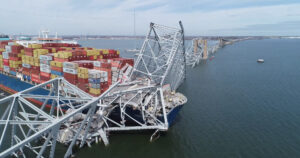Analysis by WorldTribune Staff, March 27, 2024
Following the shocking collapse of the Francis Scott Key Bridge in Baltimore, the National Transportation Safety Board said it will investigate the integrity of the bridge, the history and condition of the Singapore-flagged freighter which collided with it, as well as how quickly the crew of the MV Dali reacted to the reported malfunction that caused it to slam into one of the bridge’s support columns.
The wreckage of the I-695 bridge continues to block access to the Port of Baltimore and could disrupt shipping flows across the U.S., shipping industry officials say.

Predictably, the disaster promptly attracted a large gathering of political and media figures, not to mention the U.S. Transportation Secretary, all of whom fell short of explaining the inexplicable.
“For the shipping community, the accident will affect maritime lanes as carriers must seek alternative ports of call while the collapsed bridge continues to block the river,” FreightWaves cited industry experts as saying.
In 2023, the Port of Baltimore handled $80.8 billion in trade, including 1.1 million twenty-foot equivalent units, 1.3 million tons of roll-on/roll-off farm and construction machinery, 11.7 million tons of general cargo, and 847,158 shipments of cars and light trucks.
A number of major companies have distribution warehouses and other facilities at or near the port, including Amazon, FedEx, and BMW.
Sanne Manders, president of international at Flexport, told FreightWaves: “In the next few weeks, 107 vessels will not be able to call that port and will have to divert to other ports. The question is, are other ports able to absorb that capacity?”
The stretch of I-695 that collapsed with the bridge is the only hazmat-approved bridge in the area. All shipments of hazmat materials that used the bridge will have a large diversion in the region and beyond, industry analysts said.
Rachel Shames, vice president of pricing and procurement for CV International, a Norfolk, Virginia-based international logistics and transportation company, wrote in a market update that the bridge collapse is expected to create a temporary increase in cargo volume at other East Coast ports.
“The full impacts of this disaster are not yet known, but it’s likely that nearby East Coast ports, including Norfolk, Philadelphia, New York and others will absorb cargo traffic from Baltimore in the short term,” Shames wrote. “This sudden increase in volume may strain operations at other ports.”
Shames added that what makes the Port of Baltimore unique is the volume of roll-on/roll-off cargo it handles, such as passenger vehicles, along with agricultural and industrial equipment.
“Then you’re also getting into agricultural exports — rice, sugar, fertilizers, forestry products. It’s pretty big in Baltimore. Then there’s also a big paper industry there and construction materials,” Manders wrote. “I do think in other commodities and cars, this will have a major impact. There are also some metal exchange warehouses for nickel, tin and copper in Baltimore. Now those can also be moved to other ports, but those are bulky materials, and they don’t move them very easily.”
Maryland Gov. Wes Moore and Baltimore Mayor Brandon Scott declared a state of emergency to concentrate resources to the bridge site. About 31,000 vehicles each day use the bridge, which carries Interstate 695 over the Patapsco River in its trip around Baltimore.
Jennifer Kaufman, a property manager who commutes from her home near Dundalk to her job in Linthicum Heights, told The Washington Times that her daily drive will go from 20 minutes to now closer to an hour.
“It’s really unbelievable. I take the bridge every day. It’s surreal, like, I don’t even know. It gives me chills to even think of it,” Kaufman said. “Seven hours before that we were coming over the bridge, coming home from work. And now it’s in the water.”
Surveillance video of the Key Bridge showed the Dali’s lights flickering until it made impact with the bridge’s support beam.
While most media outlets are reporting the collapse as a tragic accident, some independent journalists are not convinced it wasn’t an act of terrorism.
Investigative journalist Lara Logan posted on X that, according to intelligence and industry sources, it was a well-planned cyber attack that disabled the Dali, causing it to take down the bridge.
Multiple intel sources: Baltimore bridge collapse was an “absolutely brilliant strategic attack” on US critical infrastructure – most likely cyber – & our intel agencies know it. In information warfare terms, they just divided the US along the Mason Dixon line exactly like the…
— Lara Logan (@laralogan) March 26, 2024
Listen to what Lara Logan says. This isn’t her opinion, this is intel. pic.twitter.com/Iun4ULv22G
— VRosen (@vrosen11) March 27, 2024
